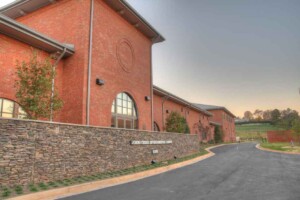Brown and Caldwell engineers create a state-of-the-art, zero-noise, zero-odor wastewater treatment plant
Brown and Caldwell engineers keep Georgia neighbors in mind with noiseless, odorless — and mostly out of sight — state-of-the-art wastewater treatment plant. You can’t see it. You can’t hear it. Most importantly, you can’t smell it. And it’s the largest facility of its kind in the country.
Brown and Caldwell engineers pulled off this triple play by creating a state-of-the-art, zero-noise, zero-odor wastewater treatment plant in Fulton County, Ga., that has earned the National Design-Build Award for a water or wastewater project of more than $25 million from the Design-Build Institute of America. The $137 million Johns Creek Environmental Campus received the excellence award during the 2010 Annual Design-Build Conference & Expo at Caesar’s Palace in Las Vegas.
The project, designed and constructed in only 40 months, faced numerous, stringent noise, odor and size requirements due to its proximity to local neighborhoods. “The JCEC design is just superb,” Paul Williams of Fulton County said. “The creative way the BC team addressed our environmental, community and financial restrictions helped to make this far more than a wastewater facility. It’s a community asset.”
The 15-mgd JCEC features low-impact design elements with extensive noise and odor abatement technologies, and will use membrane bioreactor technology to treat wastewater for non-potable reuse. It’s also the largest MBR plant in the United States. MBR facilities treat water at a higher level than the standard reclamation process and have a much smaller footprint than processes typically used in wastewater treatment.
Design integrates facility with its surroundings
The facility is built of red brick and looks much like a historic mill on the Chattahoochee River; with all treatment process taking place inside, the plant’s operation is virtually invisible to the public. “We’ll be a very good and stable neighbor,” Angela Parker, director of Fulton County Public Works, told the Atlanta Journal-Constitution.
“This design challenges the idea that wastewater treatment facilities are odorous and noisy with negative impacts on the surrounding community,” BC project manager Kelly Comstock said. “This is a prestigious award for a landmark project for Fulton County and the state of Georgia. They have set new standards for environmental excellence, fiscal responsibility and responsiveness to the community.”
The site includes a park and interpretive nature trail system, including a cascading stream and pond system, and an educational facility with a lecture hall, classroom and teaching lab so the community can learn about water quality and the local environment.
“This kind of innovation is a direct result of our partnering with the community,” County Manager Zachary Williams said in a statement. “Our collaboration with Roswell citizens was to ensure that this environmental campus not only meets their needs, but could be a model for others.”
About Design-Build
Design-build is a method of project delivery in which one entity — the design-build team — works under a single contract with the project owner to provide design and construction services, saving time and money, and reducing costly disputes between designers and constructors. Brown and Caldwell teamed with Archer Western Contractors in Atlanta on the JCEC project.
During the past 15 years, use of design-build has accelerated in the United States, making this delivery method one of the most significant trends in design and construction today.
Zero-impact design, wins award
Projects winning the National Design-Build Award best exemplify the principles of interdisciplinary teamwork, innovation and problem-solving that characterize design-build delivery. These projects frequently break new ground in their approach and accomplishments. The national design-build award is presented to the highest-rated project in each category and is the most prestigious project award presented by DBIA.



